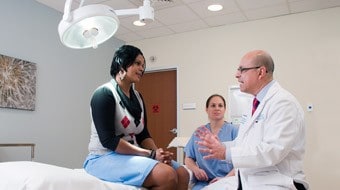Need to Know
- You will be asked to sign a consent form before the procedure is performed
- Tell your radiologist about any allergies, especially to local or general anesthetics and contrast materials (“x-ray dye”)
- If you are taking a blood thinner or aspirin product, the physician will instruct you when to stop taking these medications
- If you are diabetic, the physician will give you insulin and/or anti-diabetic medication dosing instructions
- Inform your radiologist if you are pregnant
- You should plan to have someone take you home after the procedure as you will not be able to drive after sedation
Nice to Know
- Wear comfortable, loose-fitting clothing
- You will be given a gown to wear during your treatment
- You can go home after the procedure if vitals are stable
- Most patients feel minimal discomfort after the procedure
Frequently Asked Questions
How Does A Spine Fracture Repair Work?
An interventionalist who specializes in this procedure will see you for consultation and evaluate you and your history to make sure you can benefit from the procedure. An image of your spine and lab work usually is ordered in preparation for vertebroplasty.
During the procedure, bone cement is injected with a biopsy needle into the collapsed or fractured vertebra. When a vertebra fractures, the usual rectangular shape of the bone becomes compressed and distorted, causing pain. These compression fractures, which may involve the collapse of one or more vertebrae in the spine, are a common symptom and result of osteoporosis. Osteoporosis is a disease that results in a loss of normal bone density, mass, and strength, leading to a condition in which bones are increasingly porous or full or small holes and vulnerable to breaking. Vertebrae can also become weakened by cancer.
In vertebroplasty, physicians use image guidance to inject a special cement mixture through a hollow needle into the fractured bone. The acrylic cement quickly dries and forms a support structure within the vertebra that provides stabilization and strength.
What Happens Before, During, And After A Spine Fracture Repair?
A clinical staff member will bring you into the pre-procedure area and ask you to change into a gown. An intravenous (IV) line will be inserted into a vein in your hand or arm. Your doctor will greet you, review the procedure, and answer any questions you may have. You will be brought into the procedure room, and you‘ll be positioned on the procedure table. You will be connected to a monitor for your heart rate, blood pressure, and pulse. The technologist will sterilize, and cover the area of your back where the needle will be inserted with a surgical drape. A very small nick is made in the skin at the site.
Using x-ray guidance, a hollow needle called a trocar is passed through the spinal muscles until its tip is precisely positioned within the fractured vertebra. An examination called intraosseous venography may be performed by some interventional radiologists to make sure the needle has reached a safe spot within the fractured bone. However, many interventional radiologists proceed with vertebroplasty directly and skip the intraosseous venography part of the exam.
Once the needle is in position, bone cement is injected into the bone to secure it. Several crushed bones can be treated at the same time. Pressure will be applied to stop any bleeding and the opening of the skin is covered with a bandage. No sutures are needed.
You will remain in the recovery room for an hour following the procedure.
How Should I Prepare For A Spine Fracture Repair?
There are things you can do to make your experience more comfortable, and many of these will depend on your individual preferences. You might like to keep a list of questions or – as you’re doing now- educate yourself about the procedure.
Another important part of your preparation will be guided by your doctor:
- Several days before the procedure, you will have a consultation with the interventional radiologist
- Your doctor may ask you to stop taking aspirin, non-steroidal anti-inflammatory drugs (NSAIDS), or blood thinners (such as Coumadin, Warfarin, Plavix, Fragmin) for a time before the procedure.
Some of your preparation will need to be timed to the procedure:
- The day before the procedure (or the Friday before, if you’re scheduled for a Monday procedure), a clinical staff member from the Interventional Radiology Department will call you. The clinical staff member will give you any additional instructions and will ask if you have any questions.
- Take your medications as instructed
- When you arrive, make sure the clinical staff member and radiologist know about any allergies you may have, especially allergies to local anesthetics (such as lidocaine), general anesthetics, or x-ray dye (contrast media). If there’s any chance you might be pregnant, tell your radiologist.
What Should I Bring To A Spine Fracture Repair?
On the day of your procedure you should:
- Wear comfortable, loose-fitting clothes
- Wear comfortable shoes
- A list of your current medications with dosages
- Avoid bringing jewelry or valuables
What Are The Benefits And Risks Of A Spine Fracture Repair?
The benefits of Vertebroplasty could be:
- Vertebroplasty can increase a patient’s functional abilities, allow a return to the previous level of activity without any form of physical therapy or rehabilitation and prevent further vertebral collapse
- These procedures are usually successful in alleviating the pain caused by a vertebral compression fracture; many patients feel significant relief almost immediately. Many patients become symptom-free
- Patients regain lost mobility and become more active, which helps combat osteoporosis. After the procedure, patients who had been immobile can get out of bed, reducing their risk of pneumonia. Increased activity builds more muscle strength, further encouraging mobility
- Usually, vertebroplasty is a safe and effective procedure
Risks you should be aware of include:
- Any procedure where the skin is penetrated carries a risk of infection
- A small amount of cement can leak out of the vertebral body. This does not usually cause a serious problem unless the leakage moves into a potentially dangerous location such as the spinal canal
- Other possible complications include bleeding, increased back pain and neurological symptoms such as numbness or tingling
- Paralysis is extremely rare
- There is a risk of allergic reaction to the contrast material used for intraosseous venography or to help visualize the balloon as it inflates on the x-ray image
Keep in mind that this information is general. Your radiologist is the best source of information about how these risks and benefits may apply to you.

 Vertebroplasty (Spine Fracture Repair) is a minimally invasive procedure for treating compression fractures of the spine. A compression fracture is a collapse of the bone, usually caused by osteoporosis or cancer. This procedure stabilizes the weakened or crushed bone, decreasing the pain and helping to prevent further fractures at that site.
Vertebroplasty (Spine Fracture Repair) is a minimally invasive procedure for treating compression fractures of the spine. A compression fracture is a collapse of the bone, usually caused by osteoporosis or cancer. This procedure stabilizes the weakened or crushed bone, decreasing the pain and helping to prevent further fractures at that site.





